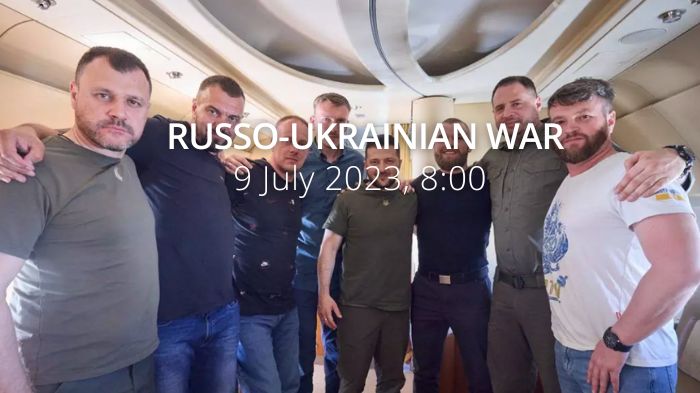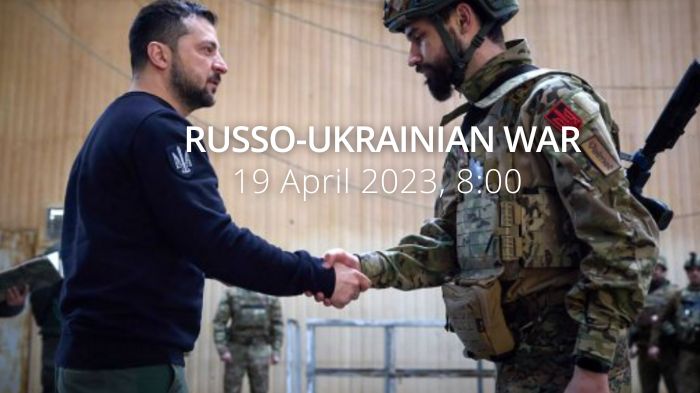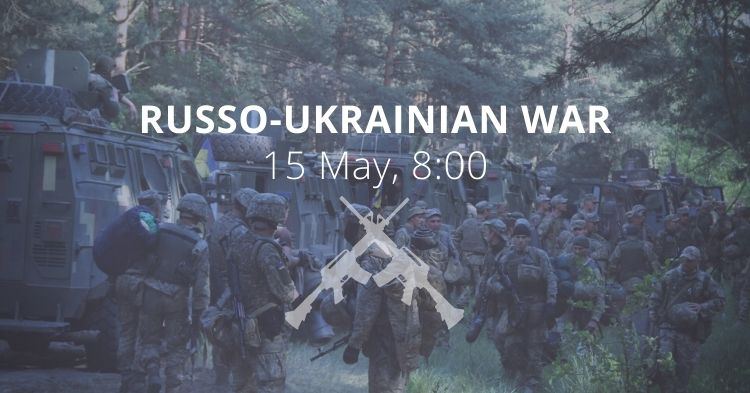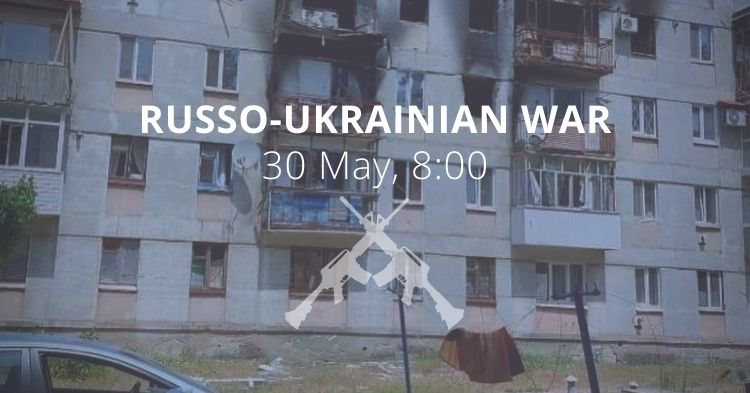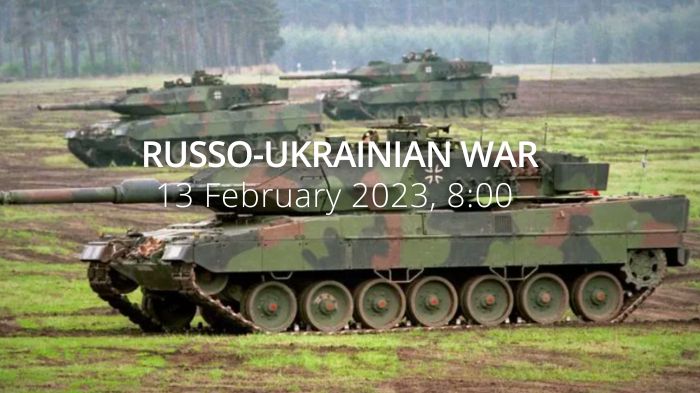Zelensky returned to Ukraine from Türkiye with five Azov commanders. Portugal becomes 23rd NATO member to declare its support for Ukraine’s NATO accession. Ukraine commits to the responsible use of cluster munitions.
Daily overview — Summary report, July 9
The General Staff’s operational update regarding the Russian invasion as of 18.00 pm, July 9, 2023 is in the dropdown menu below:
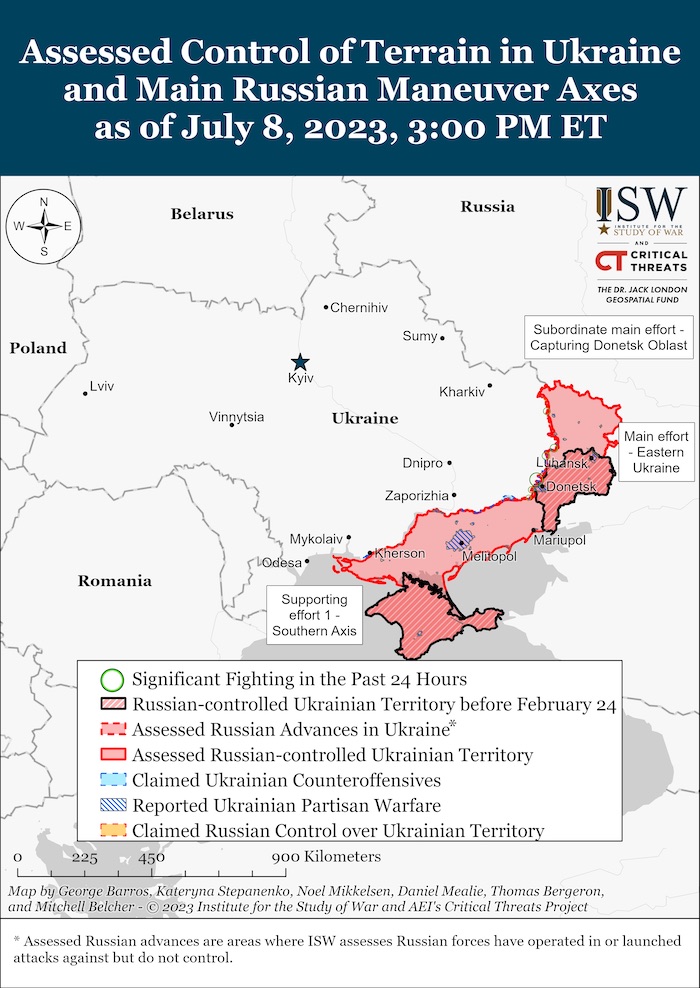
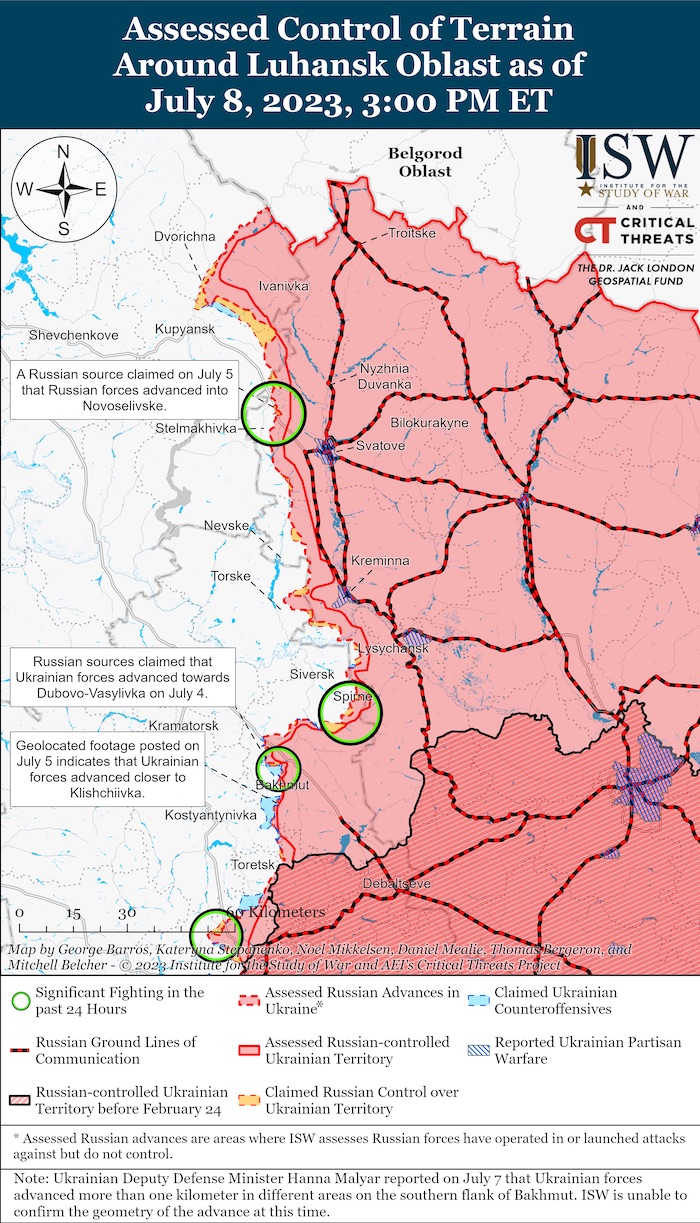
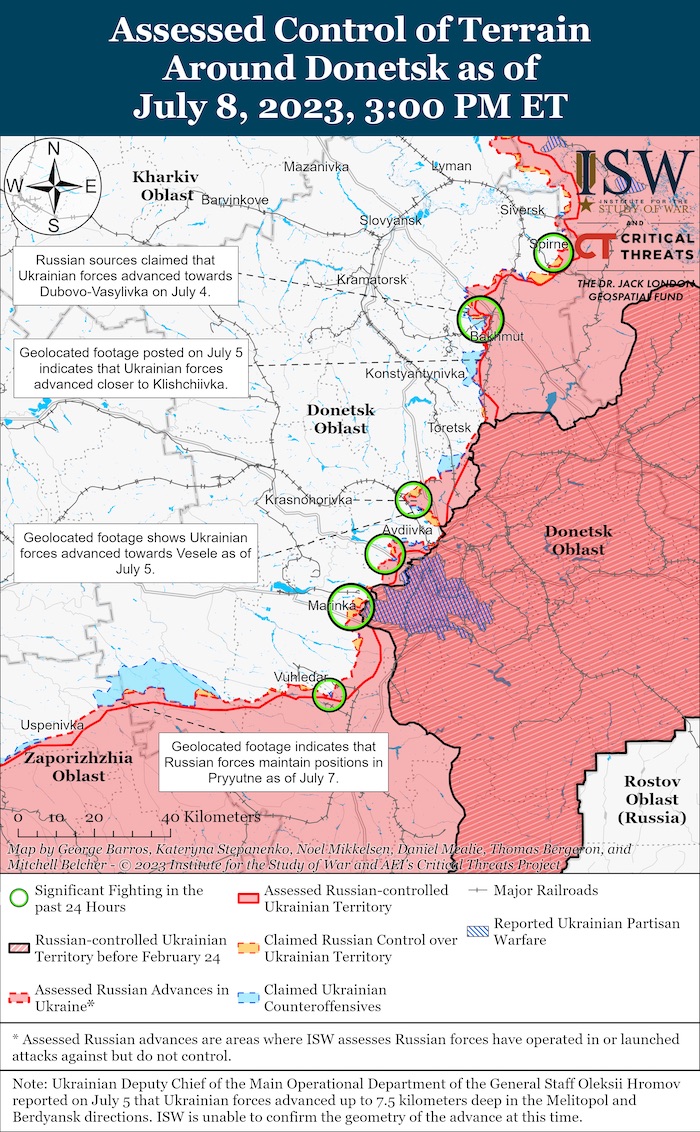
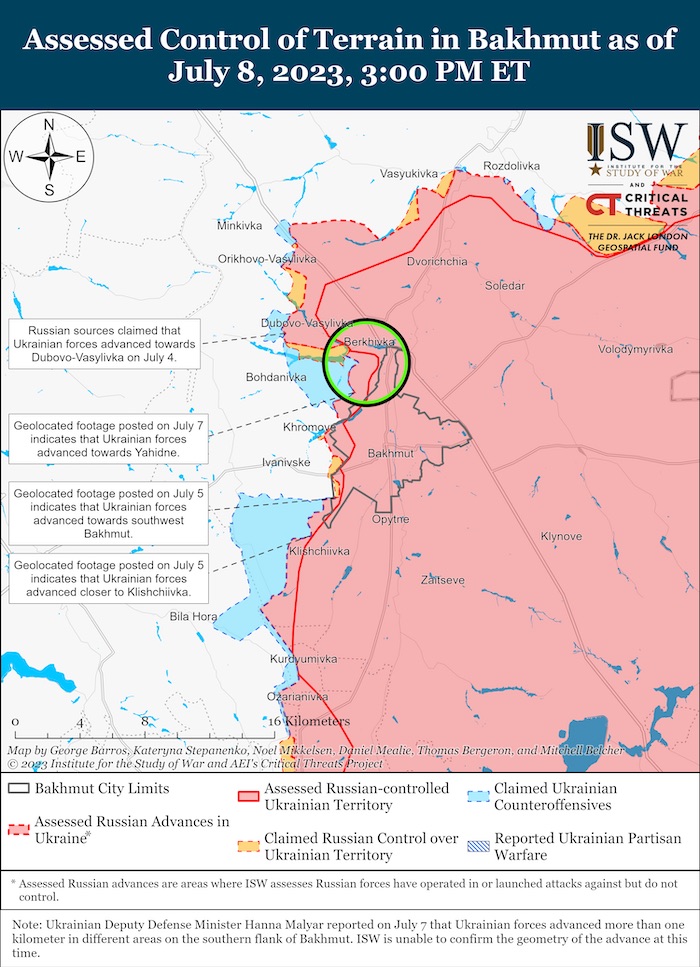


Military Updates

Biden: cluster munitions are being sent as “transition” until the US can produce more 155mm artillery. President Joe Biden has spoken out about the “difficult decision” to provide Ukraine with cluster munitions for the first time, stating that he was convinced to send the weapons due to Ukraine’s ammunition needs in its counteroffensive against Russia. The White House announced the approval of the transfer on Friday, marking another instance where the US has provided weapons to Ukraine after initial hesitation. Biden emphasized that Ukraine is running out of ammunition and highlighted the importance of supporting their efforts.
Ukraine commits to responsible use of cluster munitions, following five key principles. Ukraine has pledged to use cluster munitions while adhering to five key principles, including the prohibition of their use in cities and on Russian territory, as well as keeping track of affected areas.
According to British Defence Intelligence, (last 48 hours):
- Russian state-approved media has responded to the 24 June 2023 Wagner Group mutiny in three phases. Outlets were almost certainly initially surprised by the mutiny and were not prepared; Russian TV maintained its usual schedule.
- After the insurrection was defused, Russian state outlets sought to ‘correct’ claims that security forces had been passive. Narratives promoted the idea that President Vladimir Putin had triumphed by thwarting the insurrection, while avoiding bloodshed, and sought to unite the country behind the president.
- Nearly a week later, the state started to play down the significance of Wagner owner Yevgeny Prigozhin and the mutiny, while tarnishing his character. Wagner Telegram channels have largely gone silent, almost certainly due to state intervention. By contrast, Putin has undertaken unusually prominent public engagements, almost certainly aiming to project strength.
Losses of the Russian army

Humanitarian
Ukrainian theology professor turned sniper tells how to hunt for Russian invaders
Ukrainian Mariupol commanders returned to Ukraine from Türkiye after internment. Five Ukrainian commanders, who were responsible for the defense of the south-Ukrainian city of Mariupol in the first three months of the 2022 Russian invasion, returned to Ukraine on 8 July 2023. They spent a year on the territory of Türkiye as internment, following their release from Russian captivity during the POWs exchange on 21 September 2022.
Deadly morning attack: Russian shelling claims lives in Lyman, Donetsk Oblast. In a morning attack on Saturday, Russian forces shelled the town of Lyman in Donetsk Oblast, resulting in the deaths of at least 8 people and leaving 13 others injured. According to the head of the Donetsk Oblast Military Administration, Pavlo Kyrylenko, who reported the incident on Telegram, the shelling, conducted with multiple rocket launcher systems (MLRS), specifically hit the residential area, causing damage to a house and a shop. Kyrylenko further mentioned that the local police are present at the scene, and paramedics are providing necessary medical assistance.
Russian drones attack agricultural facility in Kryvyi Rih, causing casualties.
In the early hours of July 8th, Russian unmanned aerial vehicles (UAVs) launched an attack on Kryvyi Rih, located in the Dnipropetrovsk Oblast of Ukraine. The hostile action targeted an agricultural enterprise, resulting in significant damage and casualties. According to the head of the Dnipropetrovsk Oblast Military Administration, Serhiy Lysak, who reported the incident on Telegram, the agricultural facility was struck, leading to two separate fires that ravaged an area of approximately 360 square meters. The fires were eventually brought under control by responding firefighters.
Environmental
Russia continues to mine nuclear power plant in Zaporizhzhia – Intelligence. As per Ukraine’s Intelligence, the Russian occupiers keep on mining Europe’s largest nuclear power plant, installing mines and explosives on the ZNPP’s territory. The Russian occupants continue to mine Zaporizhzhia Nuclear Power Plant (ZNPP) and facilities on the plant, Ukraine’s military intelligence reported on 8 July.
Support
Ecumenical Patriarch Bartholomew to Zelenskyy: “Patriarchate, as the mother church of all Orthodox in Ukraine, is always on their side”. During his visit to Istanbul, Ukraine’s Zelenskyy met with Ecumenical Patriarch Bartholomew on 8 July 2023. Bartholomew conducted a memorial prayer for the victims of the war at St. George’s Cathedral. He said that “the Ecumenical Patriarchate, as the mother church of all Orthodox in Ukraine, is always on their side.“ Together with Zelenskyy, they discussed the implementation of the Peace Formula and the return of children deported by the occupiers to Russia.
New Developments
Ukraine, Türkiye sign Memorandum in the area of strategic industries. Ukraine and Turkiye signed a Memorandum of Understanding in the area of strategic industries during the working visit of Ukraine’s President Volodymyr Zelenskyy to Turkiye. “The document is aimed at promoting cooperation in strategic industries and technologies between companies of Ukraine and the Republic of Türkiye and at supporting the implementation of existing and starting new projects in these areas,” the statement reads.
Portugal becomes 23rd NATO member to declare its support for Ukraine’s NATO accession. During the telephone conversation on 8 July 2023, the President of Ukraine, Volodymyr Zelenskyy, and the Prime Minister of the Portuguese Republic, Antonio Costa, adopted Joint Declaration supporting Ukraine’s NATO membership when the war ends. The declaration also condemns the Russian invasion, supports Ukraine’s territorial integrity, and specifies Portugal’s commitments to support Ukraine.
Zelenskyy honors 500 days of war with a historic visit to Zmiinyi (Snake) Island. President Volodymyr Zelenskyy speaks to Ukrainians from Zmiinyi (Snake) Island, honoring the 500 days of Russia’s full-scale war on 8 July. In the video filmed on Zmiinyi (Snake) Island, Zelenskyy promised that “Ukraine will reclaim every part of its territory currently occupied by Russia.”
Assessment
- On the war.
The Institute for the Study of War has made the following assessment as of July 8, 2022:
Five hundred days ago Russia launched an unprovoked war of conquest against Ukraine. The Russian military intended to take Kyiv within three days but failed to accomplish any of its intended objectives in Ukraine. Determined and skillful Ukrainian resistance has forced the culmination of multiple Russian offensives including the one aimed at Kyiv and has liberated Sumy and Chernihiv oblasts, as well as the parts of Kharkiv, Mykolaiv, and Kherson oblasts that Russian forces had temporarily seized. Ukrainian forces have secured and retained the initiative and are conducting counteroffensive operations along most of the frontline with Russian forces focused almost entirely on trying to hold on to the Ukrainian lands they still occupy. With Western assistance, Ukraine has ensured its independence but faces the critical task of liberating the strategically vital territory still under Russian control.
Ukrainian forces conducted counteroffensive operations on at least three sectors of the front on July 8. Ukrainian Deputy Defense Minister Hanna Maliar reported on July 7 that Ukrainian forces advanced more than 1km on the southern flank of Bakhmut, and Russian milbloggers claimed that Ukrainian troops attacked Russian positions southwest and northwest of Bakhmut.[1] Russian sources additionally claimed that Ukrainian forces conducted offensive operations in western Donetsk and western Zaporizhzhia oblasts.[2] Ukrainian military sources confirmed that Ukrainian forces are continuing offensive operations in the Berdiansk (western Donetsk-eastern Zaporizhzhia Oblast) and Melitopol (western Zaporizhzhia Oblast) directions and are having partial success in unspecified areas of these directions.[3]
US Under Secretary of Defense for Policy Colin Kahl noted on July 7 that current Ukrainian operations across the front are the “beginning of the middle” of the wider counteroffensive and that it is therefore “too early to judge” how the counteroffensive is going.[4] Advisor to the Head of the Ukrainian President’s Office Mykhaylo Podoliak also emphasized on July 8 that Ukrainian forces are focusing on the destruction of Russian manpower as part of the first phase of counteroffensive operations and noted that the initial phase of the counteroffensive is focused on shaping the battlefield.[5] ISW continues to assess that the current pace of Ukrainian counteroffensives is reflective of the deliberate and strategic effort to create an asymmetrical attrition gradient to conserve Ukrainian combat power and attrit Russian manpower and equipment at the cost of slower territorial advances.[6]
The United States announced a new military aid package for Ukraine that includes cluster munitions on July 7. The $800 million aid package includes dual-purpose improved conventional munitions (DPICMs), and more ammunition for Patriot air defense systems and HIMARS MLRS systems.[7] US Under Secretary of Defense for Policy Colin Kahl stated that the US is providing cluster munitions to Ukraine due to the “urgency of the moment” to equip Ukrainian forces with artillery ammunition to use against Russian military targets during the counteroffensive.
Russian forces conducted another series of Shahed 131/136 drone and missile strikes against Ukraine's industrial and infrastructure facilities overnight from July 7 to 8. Ukrainian officials reported that Russian forces launched an unspecified number of Shahed drones, of which Ukrainian forces shot down five. The Ukrainian General Staff reported that the rest of the drones struck industrial and infrastructure facilities in Dnipropetrovsk and Kirovohrad oblasts.[8] The Ukrainian General Staff reported that Russian forces also used S-300 ground-to-air missiles against unspecified facilities.[9] A Russian milblogger claimed that some of the Russian drones struck storage facilities in Kryvyi Rih.[10]
Turkish President Recep Tayyip Erdogan stated that Ukraine “deserves NATO membership” ahead of the July 11 to 12 NATO summit in a press conference on July 7 in Istanbul with Ukrainian President Volodymyr Zelensky.[11] Erdogan also noted Türkiye’s support for extending the Black Sea grain deal between Ukraine and Russia and stated that he would discuss prisoner-of-war (POW) exchanges with Russian President Vladimir Putin during Putin’s visit to Türkiye in August.[12] Kremlin Spokesperson Dmitry Peskov claimed on July 8 that there is no confirmed date for the meeting between Putin and Erdogan.[13]
Zelensky returned to Ukraine from Türkiye with five Ukrainian commanders involved in the defense of Azovstal Metallurgical Combine in Mariupol, Donetsk Oblast whom Ukraine, Russia, and Türkiye had previously agreed would remain in Türkiye until the end of the war.[14] Peskov claimed that both Ukraine and Türkiye violated agreements by returning the five commanders to Ukraine and insinuated that the West forced Türkiye into releasing the commanders due to claimed Ukrainian failures in the war.[15] Russian milbloggers criticized the Russian government questioning why Russia would allow POWs to reside in a third country that is not sympathetic to Russia and why the Russian government would exchange defenders of the Azov Metallurgical Combine for former Ukrainian politician and Kremlin ally Viktor Medvedchuk.[16] Erdogan’s statements regarding the Ukrainian bid for NATO membership in addition to the release of Azovstal defenders is a notable shift in the Russia-Türkiye relationship, although the depth and permanence of Erdogan’s apparent support for Ukraine are not clear at this time.
Ukrainian intelligence indicated that Russian authorities are capitalizing on the fear of a provocation at the Zaporizhzhia Nuclear Power Plant (ZNPP) to drive out Ukrainian personnel and increase the Russian presence at the ZNPP ahead of the upcoming NATO summit. Ukraine’s Main Military Intelligence Directorate (GUR) reported that First Deputy Chief of Staff of the Russian Presidential Administration Sergei Kiriyenko and Zaporizhzhia Oblast occupation head Yevgeny Balitsky discussed providing Russian ZNPP personnel with housing seized from Ukrainians who fled occupied Enerhodar. The GUR also noted that Kiriyenko and Balitsky aim to increase the Russian presence in occupied Enerhodar by 4,500 Russian personnel.[17] The GUR reported that Russian occupation authorities continue to mine various areas of the ZNPP, including technical and machine rooms.[18] The Kremlin may seek to take additional physical control over the ZNPP operations to falsely portray Russia as the only safe operator of the ZNPP and Ukraine as a threat to the security of the plant to discourage Western support for Ukraine at the NATO summit.
A Wagner commander stated that the Wagner Group will go to Belarus after completing rest and recuperation through August 2023. A Russian milblogger published an interview with Wagner Group commander Anton “Lotos” Yelizarov on July 7, who stated that Wagner Group financier Yevgeny Prigozhin had personally ordered all Wagner personnel in Ukraine to take leave to rest until an unspecified period in early August before the Kremlin may be attempting to ensure that it has control over Wagner leadership and personnel in Africa and the Middle East. The implications of the Wagner armed rebellion for Wagner forces and Prigozhin remain unclear, but Ukraine has already benefited from the rebellion and may gain further benefits. Wagner Group has to undertake “big work” — the move to Belarus.[19] Yelizarov stated that Wagner’s Commanders’ Council needs to rotate Wagner personnel in “distant directions” (presumably meaning Wagner Group forces in Africa and the Middle East) to prepare and organize logistics for its new bases in Belarus. ISW previously reported that the status of the Wagner Group’s reorganization and possible redeployment to Belarus may not be clear until fall 2023.[20]
The status of the deal between Russian President Vladimir Putin and Prigozhin is unclear, and the deal may be in flux. Yelizarov stated that Putin promised that Russian law enforcement would not prosecute the Wagner Group, though it remains unclear why the Kremlin has not either aggressively integrated Wagner forces into the Russian Ministry of Defense (MoD) or immediately exiled them to Belarus.[21] Belarusian President Aliaksandr Lukashenka’s July 6 confirmation that Wagner forces are not in Belarus ran contrary to the public understanding that Wagner fighters should already be signing contracts with the Russian MoD, going home to retirement, or moving to Belarus.[22] Yelizarov’s interview suggests that Wagner fighters and commanders are still able to move about freely within Russia and associate with each other and that Russian authorities are not otherwise interfering with Wagner affairs beyond conducting an information operation to separate the Wagner Group from Prigozhin. The rotation of Wagner’s non-Ukraine expeditionary forces could give Prigozhin access to a cadre of loyal and capable lieutenants, presumably within Russia, if Prigozhin is controlling the rotation. ISW has seen no evidence that Russian authorities are exiling or detaining Wagner commanders or fighters who participated in the rebellion.
Putin continues to allow Wagner and Prigozhin to operate in Russia and potentially pose a threat to his regime. Allowing Prigozhin, his commanders, and as many as 25,000 Wagner fighters who led and participated in the armed rebellion apparent full freedom of movement and communication in Russia shows that Putin has either remarkable (and unwarranted) confidence in their renewed loyalty, desperation to lure as many as possible to his side, or an inability to take action against them.
The Kremlin may be attempting to ensure that it has control over Wagner leadership and personnel in Africa and the Middle East. Reuters - citing Syrian security officials, sources based near deployed Russian forces, and regional officials – reported that Syrian and Russian military commanders undertook swift measures to prevent the Wagner armed uprising from spreading among the Wagner forces in Syria.[23] Syrian and Russian officials reportedly cut phone lines, summoned around a dozen Wagner commanders to the Russian military base at Hmeimim in western Latakia Province, and ordered Wagner forces to sign contracts with the Russian Ministry of Defense (MoD) or leave Syria. A regional military source close to Damascus and two Syrian sources noted that a group of Russian military officers was quickly dispatched to Syria to take charge of Wagner forces after Prigozhin announced the start of the armed rebellion. Three sources indicated that the Russian MoD cut pay for Wagner personnel and noted that dozens of Wagner personnel were flown out to an unspecified location on Russian planes when they refused to sign contracts with the Russian MoD. Syrian officials noted that they expected more Wagner personnel to refuse to sign contracts with the Russian MoD. ISW previously reported on unconfirmed reports that Russian military police detained four Wagner commanders and visited Wagner forces in Syria.[24] The Kremlin’s swift action in Syria may indicate that the Kremlin is not confident that Wagner personnel would not pose a security risk to the Russian forces in Syria.
NBC News obtained footage that appears to show more than 600 Wagner forces departing from an airport in Bangui, Central African Republic (CAR).[25] NBC News observed that a regional newspaper also reported the departure of hundreds of Wagner personnel on July 6 and noted that it is unclear if these departures are part of a routine rotation of troops or a Kremlin-orchestrated purge of Prigozhin loyalists. A CAR official claimed that there has been no change in Wagner’s presence in the country, and senior Wagner representative Dmitry Sytii implied that Wagner forces have not been ordered to return to Russia at this time. It is possible that some Wagner personnel in CAR may be leaving after refusing to sign contracts with the Russian MoD given reports of similar departures of Wagner personnel from Syria.
The implications of the Wagner armed rebellion for Wagner forces and Prigozhin remain unclear, but Ukraine has already benefited from the rebellion and may benefit even further. Putin’s handling of the Wagner Group – Russia's most effective fighting force at this time – following the June 24 rebellion will likely keep them from fighting in Ukraine for the duration of the current Ukrainian counteroffensive and may permanently degrade Russia’s overall capability to wage war in Ukraine. The Wagner Group’s hasty withdrawal from Bakhmut disrupted Russian positions in the area and has facilitated the tactically significant gains that Ukrainian forces have been making around Bakhmut.[26]
A prominent Russian milblogger speculated that the Russian military leadership may be in the process of making the decision to replace Defense Minister Sergei Shoigu, suggesting that the implications of the June 24 Wagner Group rebellion may still be having ramifications on the highest echelons of military command. The milblogger claimed on July 7 that several factors suggest that Shoigu may be replaced, specifically citing the fact that Russian Deputy Prime Minister Dmitry Chernyashenko met with Vietnamese Deputy Defense Minister Hoang Xuan Tien in Moscow on July 6 instead of Shoigu.[27] The milblogger suggested that it is “unprecedented” for the Russian MoD to not send a representative to such negotiations, which, the milblogger asserts, suggests that the Russian military leadership may be moving to sideline Shoigu.[28] The milblogger noted, however, that it is unlikely that the final decision has been officially made yet due to Shoigu’s personal ties with regional leaders and powerful oligarchs, including within the Russian Ministry of Emergency Situations.[29] ISW cannot independently confirm rumors of Shoigu’s replacement and has, in fact, previously assessed that it is unlikely that Putin will replace Shoigu or Chief of the General Staff Army General Valery Gerasimov soon, and the Russian MoD appears to be actively interested in presenting Shoigu as an effective defense minister and posted footage of Shoigu visiting Russian contract servicemen at Southern Military District (SMD) training grounds on July 8.[30] Milblogger speculation about Shoigu’s fate indicates that the Kremlin will have to continue to balance widespread discontent with Shoigu’s and the MoD‘s leadership and conduct of the war with the desire to avoid seeming to capitulate to Wagner Group financier Yevgeny Prigozhin’s demands following Wagner’s armed rebellion.
Russian authorities reportedly prevented former Russian officer and ardent nationalist Igor Girkin from holding a talk about the Wagner Group rebellion. St. Petersburg bookstore Listva claimed on July 8 that St. Petersburg police illegally raided the bookstore to prevent Listva from hosting Girkin’s talk on the rebellion and gave the store an official warning for hosting the talk without coordinating the event.[31] Listva claimed that this raid was illegal because Russian law does not require registering events of fewer than 50 people.[32] Listva claimed that St. Petersburg authorities frequently target the bookstore, including arresting an employee for an altercation on July 7 that the bookstore describes as protecting “a Russian man who was threatened by a crowd of Tajik migrants.”[33] Girkin briefly condemned the law enforcement action, sarcastically asking whether authorities would criminally charge him for condemning the Wagner rebellion or calling for Russian victory in the war in Ukraine.[34]
Key Takeaways:
- Five hundred days ago Russia launched an unprovoked war of conquest against Ukraine.
- Ukrainian forces conducted counteroffensive operations on at least three sectors of the front on July 8. US Under Secretary of Defense for Policy Colin Kahl noted on July 7 that current Ukrainian operations across the front are the "beginning of the middle” of the wider counteroffensive and that it is therefore "too early to judge” how the counteroffensive is going.
- The United States announced a new military aid package for Ukraine that includes cluster munitions on July 7.
- Russian forces conducted another series of Shahed 131/136 drone and missile strikes against Ukraine's industrial and infrastructure facilities overnight from July 7 to 8.
- Turkish President Recep Tayyip Erdogan stated that Ukraine “deserves NATO membership” ahead of the July 11 to 12 NATO summit in a press conference on July 7 in Istanbul with Ukrainian President Volodymyr Zelensky. Zelensky returned to Ukraine from Türkiye with five Ukrainian commanders involved in the defense of Azovstal Metallurgical Combine in Mariupol, Donetsk Oblast whom Ukraine, Russia, and Türkiye had previously agreed would remain in Türkiye until the end of the war.
- Ukrainian intelligence indicated that Russian authorities are capitalizing on the fear of a provocation at the Zaporizhzhia Nuclear Power Plant (ZNPP) to drive out Ukrainian personnel and increase the Russian presence at the ZNPP ahead of the upcoming NATO summit.
- A Wagner commander stated that the Wagner Group will go to Belarus after completing rest and recuperation through August 2023. The status of the deal between Russian President Vladimir Putin and Prigozhin is unclear, and the deal may be in flux.
- The Kremlin may be attempting to ensure that it has control over Wagner leadership and personnel in Africa and the Middle East.
- A prominent Russian milblogger speculated that the Russian military leadership may be in the process of making the decision to replace Defense Minister Sergei Shoigu, suggesting that the implications of the June 24 Wagner Group rebellion may still be having ramifications on the highest echelons of military command.
- Russian authorities reportedly prevented former Russian officer and ardent nationalist Igor Girkin from holding a talk about the Wagner Group rebellion.
- Russian forces conducted ground attacks along the Kharkiv-Luhansk Oblast border and south of Kreminna, and Ukraine likely continues to conduct strikes on Russian concentration areas deep within the rear of occupied Luhansk Oblast.
- Ukrainian and Russian forces conducted ground attacks around Bakhmut.
- Russian forces conducted limited ground attacks along the Avdiivka-Donetsk City line.
- Russian and Ukrainian forces continued ground attacks along the administrative border between Zaporizhzhia and Donetsk oblasts on July 8.
- Ukrainian forces continued counteroffensive operations in western Zaporizhzhia Oblast.
- Russian Defense Minister Sergei Shoigu reportedly observed combat training of Russian contract servicemen at the Southern Military District (SMD) training grounds on July 8, likely in an attempt to favorably portray Russian formalization efforts and incentivize personnel recruitment.
- The Ukrainian government has indicated that Russian occupation authorities struggle to compensate staff in critical industries, resulting in staffing shortages that could hinder the Russian war effort.

